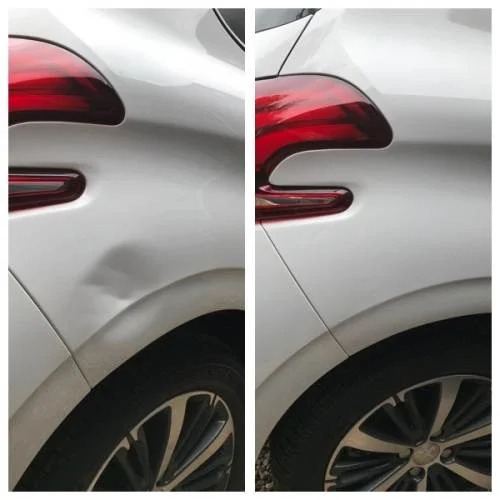Paintless Dent Removal (PDR) is an innovative process used to repair minor dents, creases, and dings without affecting the original paint job. This method is not only cost-effective but also environmentally friendly, as it eliminates the need for paint and fillers. However, the success of PDR largely depends on the type and severity of the damage. Below we explore the types of dents suitable for PDR treatment.
Understanding Paintless Dent Removal (PDR)
Paintless Dent Removal (PDR) is a unique method of car dent repair. Instead of covering dents with fillers or paint, technicians use specialised tools to gently push and pull the car’s metal back into its original shape, all while preserving the vehicle’s natural paint. There are numerous benefits to this method. It’s cost-effective compared to traditional repairs, environmentally friendly as it doesn’t use chemicals or paints, and offers a quick turnaround time. However, the main advantage is the preservation of the vehicle’s original paint and finish.
Types of Dents Suitable for PDR
Various factors determine if a dent can be fixed using PDR, such as the dent’s size, depth, and location. Here are some types of dents that PDR can typically address:
Round Dents
Usually caused by hailstorms or objects like golf balls, these dents are generally shallow and have a clear centre point. Technicians can effectively remove these by accessing the back of the dent and carefully pushing it out.
Crease Dents
These are linear dents that occur when an object strikes the car’s surface at an angle. They can be longer and sometimes more challenging to repair. However, with the right tools and expertise, PDR can be an effective solution.
Minor Collision Dents
When vehicles are involved in low-impact collisions, they can sustain larger dents. These can often be repaired using PDR, especially if the paint hasn’t been damaged.
Edge Dents
These are dents that occur near the edge of a panel. Due to their location, they might be more challenging to fix using PDR, but an experienced technician can often work wonders.
Factors Limiting the Use of PDR
- Paint Damage: If the dent has caused the paint to crack or chip, PDR might not be the best option. The primary principle behind PDR is the preservation of the original paint.
- Depth of the Dent: Very deep dents might stretch the metal and paint too much, making it difficult to restore using PDR.
- Location: Dents located in areas where it’s challenging to access the back of the panel, such as the car’s frame or near panel edges, might be more complex to repair.
Discovering Paintless Dent Removal at Storm Dents Ltd
Paintless Dent Removal, often known simply as PDR, is reshaping the way we think about car repairs. It’s straightforward: no paint, less fuss, and usually quicker. While the method is effective, the outcome often hinges on two things: the kind of dent and who’s on the job. A skilled hand can truly work wonders with PDR.
So, if you’ve found a new mark or dent on your car, consider giving us a call. At Storm Dents Ltd, we handle cars with care and make sure they return to you looking their best.
Check out our latest blog posts.
FAQs
How long does a typical PDR session last?
A typical PDR session can last from a few minutes to a couple of hours, depending on the size and number of dents.
Is PDR suitable for all car models?
Yes, PDR can be used on almost all car models, irrespective of the make and age.
Does PDR damage the car's paint?
No, PDR techniques ensure the car’s original paint remains untouched.
What's the cost of a PDR treatment?
The cost varies based on the dent’s size and complexity. However, it’s generally more affordable than traditional dent repair methods.


